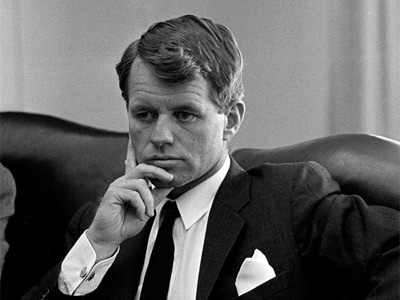When Camelot Went to Japan
Mini Teaser: RFK's public-diplomacy trip turned the relationship around.
But relocating Futenma still remains a thorny business. Hatoyama’s support for ejecting the U.S. Marines buoyed the hopes of the Okinawan antibase movement: ebullient Okinawans subsequently elected antibase mayors and a governor. Many Okinawans want the base gone—not relocated. In this new political setting, Tokyo will find it more and more difficult to relocate Futenma; it will likely require increasingly heavy-handed behavior by the center toward its resentful periphery.
Perhaps alliance managers can restructure U.S. forces in Okinawa in ways that the local population will accept. Perhaps the U.S. military can communicate better with the islanders and more effectively train U.S. soldiers so as to avoid the kind of incidents that have harmed Okinawans and aggravated relations in the past. In other words, perhaps (as Reischauer would encourage), Okinawans can be “brought in” to the alliance. Already, many locals have been brought in, because over the years marriages have connected U.S. servicemen and local families, and many livelihoods on Okinawa depend on the bases.
An alternative view, however, is that perhaps no amount of community relations (which, indeed, the U.S. military has already extensively pursued) can address the fundamental dilemma of Okinawa. A half century ago, Tokyo and Washington shook hands on a deal in which the United States would defend Japan, allowing it to enjoy a light defense burden and superpower protection, and Japan would provide bases for the U.S. military, giving a distant power a strategically located “unsinkable aircraft carrier.” Okinawa’s bases dwell at the center of this deal. Perhaps there is no amount of finessing that can both preserve the alliance and satisfy Okinawans.
SIMILARLY, PERHAPS there is a limit to the United States’ ability to create warm relationships with some of its contemporary allies in the Middle East, where anti-American sentiment is strong. Nevertheless, the case of the U.S.-Japanese alliance offers lessons as Washington seeks to maintain and improve its crisis-prone relationships in the Middle East, where Washington retains some unfortunate diplomatic habits.
In his book Imperial Life in the Emerald City, Rajiv Chandrasekaran chronicles how personnel for the Coalition Provisional Authority (CPA) in Iraq were chosen not for their professional expertise or regional knowledge but instead for their loyalty to the George W. Bush administration. Once in Iraq they fortressed themselves away from the local population. In an eerie echo of the U.S. occupation of Japan, Chandrasekaran writes of the CPA diplomats: “Many of them spent their days cloistered in the Green Zone, a walled-off enclave in central Baghdad with towering palms, posh villas, well-stocked bars and resort-size swimming pools.”
The already-problematic U.S. tendency to build high walls around its diplomats will be exacerbated in the era after the Benghazi attacks in Libya. As tragically highlighted by the murder of U.S. ambassador J. Christopher Stevens and other officials in Libya, U.S. diplomats face threats that are real and dire. Even in the comparatively low-threat Japan of the 1960s, it is important to note, Edwin Reischauer encountered a knife-wielding Japanese man in the embassy and suffered a terrible stabbing; he survived.
But, as the U.S.-Japanese experience shows, relations will suffer if diplomats’ encounters with an ally’s people are confined to glimpses through the window of a speeding limousine. Reischauer, Robert Kennedy and their Japanese partners transformed U.S.-Japanese relations by reaching out to the public. The United States has a powerful story to tell about religious tolerance, respect for diversity and governance by law. It needs to tell that story—even if it is shouted offstage in its first attempts.
The U.S.-Japanese case also shows that greater dialogue with an ally’s public—assisted by area experts such as Reischauer—can help American policy makers hear and understand the issues that are important to allies and thus help them identify vital accommodations that can sustain these relationships. Reischauer’s knowledge of Japan and his deep contact with its people, as well as the subsequent Hakone conversations among U.S. and Japanese leaders about Okinawa, paved the way for the return of Okinawa to Japanese sovereignty—and averted what could have been an alliance-killing crisis between the two countries. In postinvasion Iraq, Chandrasekaran comments, while Iraqis were thrilled to be liberated and were eager to create a new country, “The CPA, in my view, squandered that goodwill by failing to bring the necessary resources to bear to rebuild Iraq and by not listening to what the Iraqis wanted—or needed—in terms of a postwar government.”
Edwin Reischauer saw the rehabilitation of the U.S.-Japanese alliance as critically important in itself. But he also viewed it as a model for relations “across cultural and racial lines for the whole world.” He argued that the United States and Japan enjoyed “the closest relations that have ever been developed between a Western country and a major nation of non-Western cultural background.” It’s worth pondering how the lessons of the rescue of the U.S.-Japanese alliance might be usefully applied elsewhere, even if the prospects for a similar transformation may at first appear dim.
Jennifer Lind is an associate professor of government at Dartmouth College.
Image: Pullquote: After Robert Kennedy's visit, the RK committee grew into a number of activities and institutions designed to foster an alliance between peoples rather than between governments.Essay Types: Essay
Pullquote: After Robert Kennedy's visit, the RK committee grew into a number of activities and institutions designed to foster an alliance between peoples rather than between governments.Essay Types: Essay 